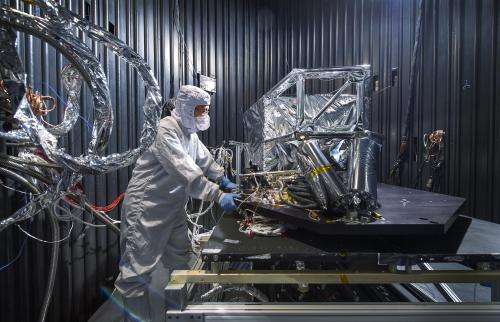Thermal shield testing on Webb's MIRI

(Phys.org) —NASA engineer Acey Herrera recently checked out copper test wires inside the thermal shield of the Mid-Infrared Instrument, known as MIRI, that will fly aboard NASA's James Webb Space Telescope. The shield is designed to protect the vital MIRI instrument from excess heat. At the time of the photo, the thermal shield was about to go through rigorous environmental testing to ensure it can perform properly in the extreme cold temperatures that it will encounter in space.
Herrera is working in a thermal vacuum chamber at NASA's Goddard Space Flight Center in Greenbelt, Md. As the MIRI shield lead, Herrera along with a thermal engineer and cryo-engineer verify that the shield is ready for testing.
On the Webb telescope, the pioneering camera and spectrometer that comprise the MIRI instrument sit inside the Integrated Science Instrument Module flight structure, that holds Webb's four instruments and their electronic systems during launch and operations.
Webb is designed to obtain images and spectra in infrared light that is invisible to the human eye. As a consequence, the Webb telescope and ISIM must be cooled to a very low temperature (-383 F or -230 C) in order to avoid being blinded by their own infrared emission. The MIRI operates over longer infrared wavelengths than the other Webb instruments and, as a result, must be made approximately 35 degrees colder than the rest of the ISIM. The MIRI's thermal shield is critical to achieving this lower temperature for the MIRI.
Herrera said the copper wires he's looking at are located inside the silver box, are important for regulating the temperature of a mock-up of the MIRI instrument enclosed by the shield.
"The wire harness or black coils, half hidden from view at the front, is part of ground support equipment to a heat flow meter that helps regulate and monitor cooling of our test payload," Herrera said. In the left of the photo are lines that will be filled with liquid helium that will cool the chamber.
Surrounding the shield are tangles of cables that provide power to heaters and lead to temperature sensors that will help control and assess how the shield intercepts heat. Parts of the MIRI thermal shield are covered with aluminized thermal blanketing material to keep them cooler.
Inside the thermal vacuum chamber, all of this hardware was tested in an environment that mimics the strong vacuum and cold temperatures that Webb will experience in space. After Herrera and the others finished setting things up in the test chamber, Goddard technicians sealed it up, evacuated all the air and lowered the temperature of the equipment to 18 to 23 kelvins (-427 F or -255 C).
"The heaters here regulate the temperature of this huge, black painted test plate," said Herrera. "The copper wires in the center lead to a mockup meant to represent the volume of the MIRI instrument which will be enclosed in the MIRI shield."
The two black cylindrical parts at the front are protective pads covering two of six composite struts that will attach to ISIM; the pads will be removed before flight.
"These struts are designed to limit the conducted heat flow into the shield from ISIM," said Mark Voyton, MIRI instrument manager at NASA Goddard. "Underneath the shield is a black rectangular piece, part of the thermal shroud that mimics the MIRI shield's environment."
Engineers then used a Q-meter, a device designed to maintain temperature and measure the heat flow, to monitor the instrument. The test took three weeks to complete.
The James Webb Space Telescope is the successor to NASA's Hubble Space Telescope. It will be the most powerful space telescope ever built and will observe the most distant objects in the universe, provide images of the first galaxies formed, and see unexplored planets around distant stars. The Webb telescope is a joint project of NASA, the European Space Agency and the Canadian Space Agency.
Provided by NASA





















